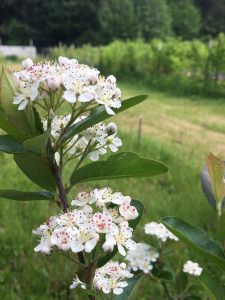Week six started out with much warmer spring like temperatures and sunny skies. Beth and I decided it would be best for me to continue to focus on honing my skills with the BCS walk behind tractor and irrigation set up and maintenance.
I was able to accomplish both chores while working on the hedgerow I helped plan and install last year as a POF student. My area of focus last year was integrated pest management (IPM). Our IPM group mapped out a hedgerow 100 feet long with three rows spaced 4 feet apart. We installed native shrubs such as snowberry and serviceberry, along with several shrubs sourced from Burnt Ridge Nursery in Onalaska, Washington.
http://www.burntridgenursery.com/
The shrubs we planted included Viking Aronia, Golden Silverberry, and Autumn Olive. Aronia (Aronia melanocarpa) is a shrub with small black edible berries that are highly nutritious and attractive to pollinators and wildlife. It is a self fruitful shrub, meaning it transfers pollen from the anther to the stigma on the same flower to another flower on the same plant. Many plants cannot produce fruit from their own pollen, they need pollen from another flower of a genetically different plant or cultivar to set fruit. Many varieties of apples, cherries, and pears need another variety nearby to cross pollinate and produce fruit. An example would be the asian pear variety Housi, planted in close proximity to another asian pear variety such as Shinko or Kosui. Pollination is performed by bees, it is important to attract bee activity by providing flowers. Another method used to attract wild mason bees is to install a mason bee home. This is done by drilling a hole 4/16 inch in a 4 inch wide piece of untreated lumber. The bee house should be installed 6-7 feet from the ground.

Most of the plantings from last year survived, I was able to make an inventory by accessing the planting map from our initial installation from last year. The practice of having a dated map of planting location and plant varieties is crucial to operating a well organized farm. This is a practice that I have started using on my farm and an important lesson I learned during my internship. Many of the plants from last year had lost their tags, having a concise map with measurements saves time and eliminates guesswork.
After mowing around the hedgerow I inspected and repaired the irrigation lines, next I weeded and applied a thick layer of wood chips to help conserve moisture and suppress the weed pressure.